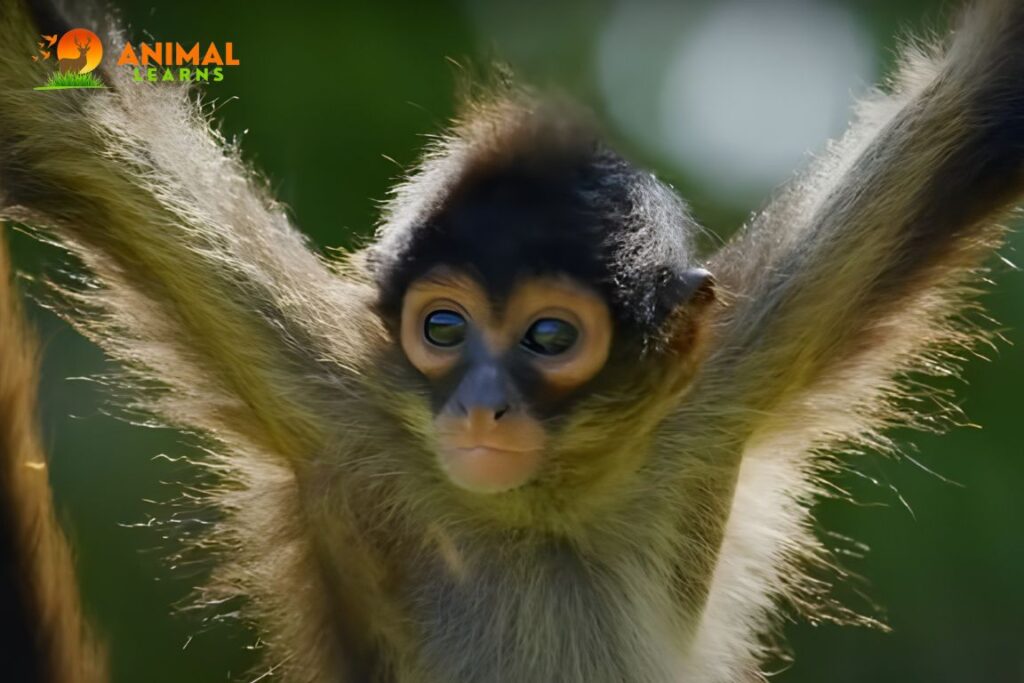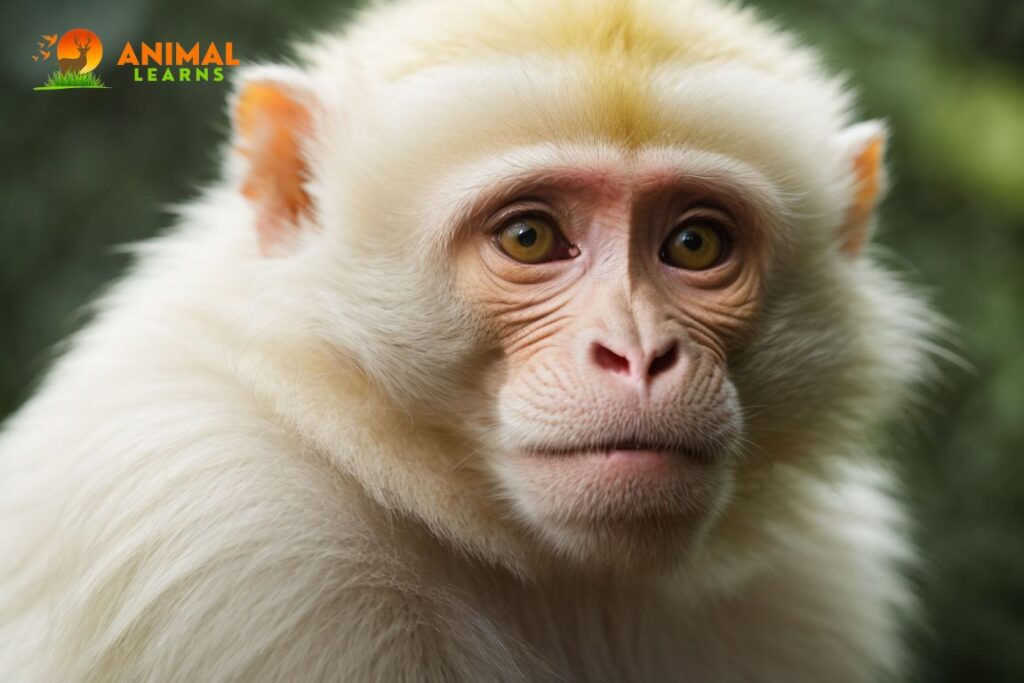Albino Monkeys: How Nature Makes Them Rare and Unique
Ever imagined albino monkeys in a lush jungle? Snowflake-like monkeys with curious, sparkling pink eyes amid the greenery.
This is not a fairy tale, but a reality for some rare and amazing primates that live in the African rainforest. They are called albino monkeys, and they are one of the most fascinating discoveries in the history of wildlife.
Albinos are born with a special gene that makes them produce less melanin, the pigment that gives color to skin, hair, and eyes. This makes them stand out from their normal-colored relatives, who have brown or black fur and dark eyes.
These are very rare, and very few have been seen by humans. They are like hidden gems in the forest, waiting to be discovered.
Albino monkeys, devoid of pigmentation, exhibit a unique and striking appearance, drawing attention to their distinctiveness in the primate world, much like the captivating features of tigers and bears in the animal kingdom.
In this article, we will explore the wonderful world of albinos, and learn more about their characteristics, habitat, behavior, and conservation. We will also see some stunning photos of these beautiful animals, and marvel at their unique appearance.
If you are ready to embark on an adventure into the unknown, read on and discover the secrets of monkeys.
The appearance
Contents
- 1 The appearance
- 2 Characteristics
- 3 Species of Albino Monkeys
- 4 Regions and Habitat
- 5 how long do albino monkeys live
- 6 Behavior
- 7 how many albino monkeys are left in the world
- 8 What is Albinism?
- 9 What Are Half-Albino Monkeys?
- 10 Cause of Half Albino Monkeys
- 11 Challenges
- 12 Interesting Facts About Albino Monkey
- 13 The Rarity of Albino Monkey: An Exploration of Their Unique Features
- 14 A Fascinating Subject of Study: Albino Monkey as Rare Mammals
- 15 Conserving Albino Monkey: Their Natural Habitat and Survival Challenges
- 16 Ensuring a Bright Future: The Mission to Protect Albino Monkey
- 17 Predators
- 18 Conclusion
- 19 FAQs

In addition to having red eyes, they have white hair and white skin, making them quite different from other monkeys. They come in a variety of sizes, starting with the pygmy marmoset.
In some species, they can grow up to 3.5 feet long and 80 pounds in weight. Other species can grow up to 4.6 inches with a 6.7-inch tail.
Characteristics
Lack of Melanin Production and Their Distinct Appearance
They are rare and beautiful animals that have a genetic condition called albinism. They have very little or no melanin, the pigment that colors our skin, hair, and eyes. Because of this, they have some unique features that make them stand out from the crowd:
White Fur
They have pure white fur that contrasts with the green jungle. Their fur is often softer and finer than normal-colored monkeys.
Pink Eyes
These monkeys have pink or red eyes that sparkle with curiosity. Their eyes are pink because the blood vessels show through their transparent irises, which have no color.
Pale Skin
These monkeys have pale, almost see-through skin that reveals their veins and muscles. Their skin has no protection from the sun’s rays.
Effects on Vision and Sunlight Sensitivity
But being an albino is not all fun and games. They also face some serious challenges that affect their vision and health:
Vision Problems
These monkeys have trouble seeing clearly and adjusting to different light levels. They may suffer from photophobia (light sensitivity), nystagmus (eye twitching), and poor depth perception. These problems make it harder for them to find food and avoid predators.
Sunburn and Skin Cancer
These are very sensitive to sunlight and can get sunburned easily. They also have a higher risk of developing skin cancer and other diseases caused by UV damage. They need to stay in the shade and hide under the leaves to protect their skin.
They are not only found in one species but in many different kinds of primates, including lemurs, apes, and humans. Each species has its way of adapting to albinism, depending on its evolution and environment. For example, some albino lemurs have blue eyes instead of pink, while some albino apes have darker skin than others.
They are fascinating creatures that teach us about the diversity and complexity of life on Earth. They are also endangered animals that need our help to survive and thrive in their natural habitats. By learning more about them, we can appreciate their beauty and value their existence.
Species of Albino Monkeys
Although rare, albinism has been found in several monkey species, leading to visually striking and fascinating creatures distinguished by their typical white or pale look. The story that follows explores some of the primate species that are known to display albinism:
Albino Gorillas

| Characteristic | Description |
|---|---|
| Appearance | Pink or pale skin, white or pale fur, red or pink eyes |
| Lifespan | Similar to non-albino gorillas (30-50 years) |
| Habitat | Rainforests of Central and West Africa |
| Diet | Primarily herbivorous, including fruits, leaves, and stems |
| Social structure | Live in groups led by a dominant silverback male |
| Population | Extremely rare, with only a handful of documented cases |
| Geographic Distribution | Equatorial Guinea, Cameroon, Gabon, and possibly other countries in Central and West Africa |
| Threats | Poaching, habitat loss, and discrimination |
| Conservation Status | Critically endangered |
It is quite uncommon for gorillas to be albino. Perhaps the most well-known albino gorilla is Snowflake, a Western lowland gorilla that resides in the Barcelona Zoo. Snowflake was unique up to his passing in 2003 because of his albinism, which was the result of inbreeding.
His attractive pink-colored eyes and white fur have greatly contributed to our understanding of monkey albinism.
Albino Capuchin Monkeys
| Characteristic | Information |
|---|---|
| Scientific Name | Cebus capucinus |
| Habitat | Tropical rainforests of Central and South America |
| Diet | Omnivorous (fruits, insects, small animals) |
| Lifespan | 15-20 years |
| Social Structure | Live in groups of 10-30 individuals |
| Skin | Pink or pale |
| Fur | White or pale |
| Eyes | Red or pink |
| Vision | Reduced, with nystagmus and photophobia |
| Albino Trait Cause | Genetic mutation |
| Population | Unknown, but rare |
| Conservation Status | Not listed as threatened, but vulnerable due to rarity and susceptibility to sunburn and predators |
Despite being uncommon, albinism has been observed in capuchin monkeys, who are valued for their intelligence and frequently used as service animals and research subjects. An albino capuchin would have red or pink eyes, skin, and fur that is white or very pale in hue.
Because these monkeys rely primarily on visual signals for social interaction, the effect of albinism on their relationships with other Capuchins may be significant.
Albino Orangutans
| Characteristic | Description |
|---|---|
| Fur Color | White or pale cream |
| Skin Color | Pink or pale |
| Eyes | Blue or pale grey |
| Vision | Reduced vision, photophobia |
| Lifespan | Similar to non-albino orangutans (40-50 years) |
| Population | Extremely rare, currently only one known individual (Alba) |
| Habitat | Rainforests of Borneo and Sumatra |
| Diet | Primarily fruit, with some leaves, flowers, and insects |
| Social Structure | Solitary, except for mothers and young |
| Conservation Status | Critically endangered |
| Threats | Habitat loss, hunting, and illegal pet trade |
Orangutans with albinism are rare; they are usually identified by their reddish-brown fur. One well-known case is Alba, a female Bornean orangutan that was saved in Indonesia.
“Alba,” which means “white” in Latin and “dawn” in Spanish, is now thought to be the only example of an albino orangutan in the world.
Albino Spider Monkeys

| Feature | Description |
|---|---|
| Scientific name | Ateles geoffroyi |
| Appearance | White or pale fur, pink or pale skin, red or pink eyes |
| Vision | Nystagmus, strabismus, photophobia, hypopigmentation of the retina, foveal hypoplasia |
| Other symptoms | Decreased visual acuity, increased risk of sunburn |
| Population | Unknown, likely very low |
| Habitat | Tropical rainforests of Central and South America |
| Diet | Fruits, leaves, flowers, insects |
| Social behavior | Live in groups of 10-30 individuals |
| Threats | Habitat loss, hunting, illegal pet trade |
| Conservation status | Vulnerable |
Spider monkeys are native to the tropical woods of Central and South America, and there have been reports of albinism in them. Predators may be more likely to notice albino spider monkeys due to their striking contrast with the verdant forest canopy.
Regions and Habitat
| Regions or Countries | Types of Environments | Habitat-Survival Relationship |
| 1. Congo Basin, Africa | Dense Rainforests | Albinos in the Congo Basin live in the lush, dense rainforests, where they can find plenty of food like fruits and leaves. – The thick canopy provides shelter from predators and harsh sunlight. |
| 2. Amazon Rainforest, South America | Diverse Ecosystems | Albinos in the Amazon Rainforest live in diverse ecosystems, including tropical rainforests and flooded forests. – Their habitat diversity gives them access to various food sources, helping them survive. |
| 3. Madagascar | Deciduous Forests | Albino lemurs in Madagascar are found in deciduous forests, which offer seasonal variations in food resources. – The deciduous forests have a mix of fruit-bearing trees and open spaces for foraging. |
| 4. Southeast Asia | Primary Rainforests | In Southeast Asia, albino gibbons and langurs live in primary rainforests, rich in biodiversity. – These rainforests have a continuous supply of fruits, leaves, and insects, supporting their dietary needs. |
| 5. Central Africa | Savannas and Woodlands | Some albinos in Central Africa are seen in savannas and woodlands, where they may have adapted to a different mix of vegetation. – These habitats may offer opportunities for ground-based foraging and social interactions. |
As you can see, albino monkeys have adapted to different environments and habitats across the world. They have learned to use their natural resources to survive and thrive in their own ways. They are fascinating creatures that teach us about the diversity and complexity of life on Earth.
They are also endangered animals that need our help to protect them from the threats they face in their natural habitats. By learning more about them, we can appreciate their beauty and value their existence.
how long do albino monkeys live
Depending on the species and whether they are kept in captivity or the wild, albino monkey lifespans might differ. Nonetheless, albino monkeys often have shorter lives than non-albino peers. This is caused by several things, such as:
- Heightened vulnerability to sun damage: Melanin, the pigment that shields skin from UV radiation, is absent in albino monkeys. Skin cancer and other health issues may result from this.
- Diminished eyesight: Because albino monkeys frequently have low vision, it may be challenging for them to locate food, evade predators, and navigate their surroundings.
- Social isolation: Because of their peculiar look, albino monkeys may be rejected by their social groupings. Their lifetime may be shortened as a result of stress and loneliness.
Some albino monkeys have managed to live long and healthy lives despite these difficulties. For instance, the albino gorilla Snowflake, who was housed at the Barcelona Zoo, lived to be 26 years old. This is more mature than the typical gorilla lifetime in captivity.
The average lifespans of several distinct species of monkeys, both albino and non-albino, are shown in the following table:
| Species | Average Lifespan (Wild) | Average Lifespan (Captivity) |
|---|---|---|
| White-faced capuchin | 20-30 years | 45 years |
| Spider monkey | 20-30 years | 40 years |
| Macaque | 20-30 years | 30 years |
| Squirrel monkey | 15-20 years | 30 years |
| Marmoset | 5-10 years | 10-15 years |
| Rhesus Monkey | 25-30 years | 35 years |
| Japanese Macaque | 20-30 years | 30 years |
| Howler Monkey | 15-20 years | 20 years |
Behavior

Daily Routines and Behaviors of Albino Monkey:
These monkeys have many things in common with their normal-colored relatives. They mostly eat fruits, leaves, and flowers, which they find in the trees or on the ground. They often forage in groups, which can range from a few individuals to hundreds of members. These groups help them find food and protect each other from predators.
They are also very social animals. They groom each other, make sounds, and share food with their friends and family. These behaviors help them strengthen their bonds and communicate their emotions. They can be very affectionate and playful with each other.
how many albino monkeys are left in the world
Regretfully, the specific number of albino monkeys that still exist in the world is unknown. This is due to:
- Albino monkeys are rare: Since albino monkeys are uncommon and only seldom seen, it is challenging to properly monitor their numbers.
- Difficulties in identification: Because albino monkeys are secretive and camouflaged, observing and recognizing them in deep forests may be difficult.
- Lack of comprehensive surveys: There aren’t many extensive studies that concentrate only on albino monkeys, which results in insufficient data.
What is Albinism?
A genetic disorder called albinism impairs the synthesis of melanin, the pigment that gives skin, hair, and eyes their color. It is caused by a mutation in many genes involved in the synthesis or distribution of melanin.
In most cases, albinism is inherited in an autosomal recessive form in albino animals, meaning that for an offspring to be affected by the trait, both parents must have the gene.
Many different animals, including monkeys, are affected by it. Regrettably, the health problems associated with albinism also affect albino monkeys.
Symptoms of Albinism in Monkeys
- Pink or pale skin: Since melanin, which determines skin color, is absent from monkeys’ skin, the most obvious sign of albinism in these animals is pink or pale skin.
- White or pale fur: Because albino monkeys do not produce melanin, their fur is also white or pale in hue. It may also affect the eyes and other hair-growing regions.
- Red or pink eyes: Albino monkeys’ eyes look red or pink due to a lack of melanin in their irises. This is a result of the transparent iris making the blood vessels in the eye visible.
What Are Half-Albino Monkeys?

A genetic mutation that affects the distribution or synthesis of melanin in particular body areas is the cause of half-albinism in monkeys. There have been reports of both complete and half-Alpino monkeys seen in the wild.
Due to the non-dominant nature of the albinism gene, children cannot inherit the condition unless both parents are affected.
Cause of Half Albino Monkeys
In monkeys, a genetic mutation that alters the distribution or synthesis of melanin in particular body regions results in half-albinisms. In the wild, whole and half-Alpino monkeys have both been seen.
Given that the albinism gene is not dominant, children cannot be born with the condition unless both parents have the gene.
Challenges
But being an albino monkey is not always easy. They face some unique challenges because of their lack of camouflage. Their bright white fur makes them more visible to predators, especially in dense forests where they live. They have to be very careful and alert when they move around their habitat.
Albino may also have some difficulties fitting in with their groups. Some non-albino may reject or bully them because of their different appearance. But these are not alone. They often have supportive friends and family who help them overcome these challenges.
Interesting Facts About Albino Monkey

- These monkeys are stunning animals with a distinct and eye-catching appearance. Their fur is pure white or pale, and their skin and eyes lack the typical pigmentation seen in their non-albino counterparts. This striking appearance sets them apart from other primates in their habitat.
- They are highly sensitive to sunlight, which can damage their skin and eyes. They can easily sunburn and develop skin conditions when exposed to intense UV radiation. As a result, they often seek shade in their habitats to protect themselves from the sun’s harmful effects.
- Another challenge that monkeys face is camouflage. Their bright white coloration stands out against the lush greenery of their rainforest or woodland habitats, making them more vulnerable to predators. This lack of natural camouflage can be a significant disadvantage in the wild.
- Despite these challenges, monkeys are not loners. They are social animals that live in family groups or troops. They engage in various social behaviors, such as grooming and vocalizations, to strengthen bonds within the group. Despite their unique appearance, they often exhibit similar social structures and behaviors as their non-albino peers.
- They are fascinating animals that deserve our admiration and respect. They are rare and beautiful creatures with a unique genetic condition that affects their appearance and survival. By studying and conserving albino monkey, we can learn more about their diversity and contribution to the primate world.
The Rarity of Albino Monkey: An Exploration of Their Unique Features
They are indeed real, but they are exceptionally rare in the wild. These enchanting creatures stand out with their unique features, such as albinos with black hair, big ears, or striking blue eyes.
A Fascinating Subject of Study: Albino Monkey as Rare Mammals
These are mammals, and their rarity makes them a fascinating subject of study for researchers. There is a growing interest in albino monkey, and this is reflected even in virtual worlds like Adopt Me, where players can own and trade albino monkey with various names and values. The neon versions of these albinos are particularly sought after in the game.
Conserving Albino Monkey: Their Natural Habitat and Survival Challenges
In their natural habitat, albinos can be found in select regions, often characterized by dense rainforests and lush vegetation. Due to their scarcity and the challenges they face in the wild, it’s crucial to raise awareness about these unique primates.
Ensuring a Bright Future: The Mission to Protect Albino Monkey
As we learn more facts about these monkeys, it becomes evident that their survival is a concern. Efforts to protect their habitat and ensure their well-being are essential to prevent them from becoming even rarer.
Conservationists and animal enthusiasts are united in their mission to safeguard these exceptional creatures and monitor their dwindling population to answer the question: how many albinos are left in the world?
Predators
Normally, monkeys must deal with predatory animals to survive, but albino monkeys have a very difficult time surviving. Because Albinism prevents monkeys from producing color pigments in their skin, hair, feathers, and scales, they find it more challenging to thrive in their environment. Leopards, hyenas, eagles, and snakes are among the animals that feed on primates.
Among the larger monkeys’ predators are big cats, crocodiles, hyenas, and humans, while birds occasionally prey on extremely young or small monkeys.
Conclusion
Albino monkeys are rare and amazing animals that fascinate us with their appearance and behavior. They have no pigmentation in their skin, hair, and eyes, which gives them a striking white look. However, this also makes them face some difficulties in their environment, such as blending in with their surroundings and protecting themselves from the sun.
Despite these challenges, albino monkeys are able to adapt and survive in their natural habitats, adding to the richness and diversity of life on Earth.
We need to appreciate and protect albino monkeys and their role in the ecosystem. They are part of the complex web of life that supports our planet’s health and balance.
By helping to conserve their habitats and genetic diversity, we can ensure that they have a future and that we can continue to learn from them. These are not only beautiful and unique animals, but also important members of our global community.
To Read More Articles like Can Dogs See Color and Others Click on Animallearns.com
FAQs
What is albinism in monkeys?
Albinism is a genetic condition that makes monkeys have no melanin pigment, giving them white or pale fur, skin, and eyes.
How do albino monkeys adapt to their lack of pigmentation in the wild?
They avoid sunburn by seeking shade. They depend on their group for defense and protection.
Why are albino monkey considered rare and unique?
Albino monkey is uncommon and unique animals. Albinism makes them have white or pale fur, skin, and eyes. They need to protect themselves from the sun.
What challenges do albino monkey face due to their lack of natural camouflage?
Albino monkeys have a hard time hiding from their enemies in the wild. Their bright white fur makes them easy to spot among the green plants and trees. This puts them in danger of being attacked by other animals who want to eat them.
Why is conserving albino monkeys important?
Albino monkeys are important animals that we need to save. They have special genes that make them different from other primates. They also help to keep their ecosystems healthy and diverse.














